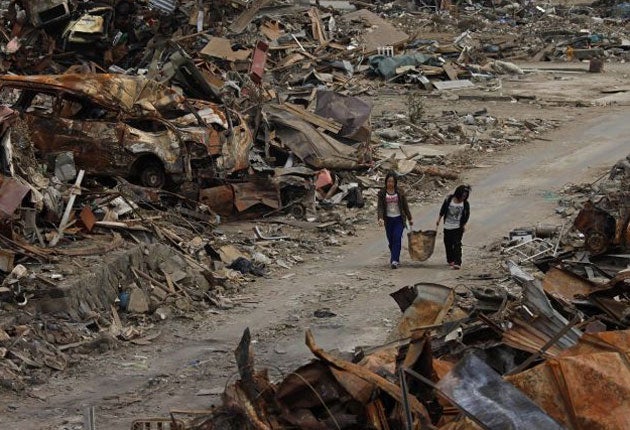Your support helps us to tell the story
From reproductive rights to climate change to Big Tech, The Independent is on the ground when the story is developing. Whether it's investigating the financials of Elon Musk's pro-Trump PAC or producing our latest documentary, 'The A Word', which shines a light on the American women fighting for reproductive rights, we know how important it is to parse out the facts from the messaging.
At such a critical moment in US history, we need reporters on the ground. Your donation allows us to keep sending journalists to speak to both sides of the story.
The Independent is trusted by Americans across the entire political spectrum. And unlike many other quality news outlets, we choose not to lock Americans out of our reporting and analysis with paywalls. We believe quality journalism should be available to everyone, paid for by those who can afford it.
Your support makes all the difference.Japan was rattled by a magnitude-7.4 aftershock today nearly a month after a devastating earthquake and tsunami flattened the northeastern coast.
The strongest aftershock since the day of the magnitude-9.0 megaquake was a fresh blow to victims of that March 11 quake and subsequent tsunami that killed some 25,000 people, tore apart hundreds of thousands of homes and has sparked an ongoing crisis at a nuclear power plant.
Damage and injuries from the aftershock were not immediately clear. The Japan meteorological agency briefly issued another tsunami warning tonight, but later cancelled it.
Officials at the tsunami-ravaged Fukushima Dai-ichi nuclear plant said there was no immediate sign of new problems caused by the aftershock. Japan's nuclear safety agency says workers there have retreated to a quake-resistant shelter in the complex. No one there was injured.
Officials say today's aftershock hit 30 miles under the water and off the coast of Miyagi prefecture. The quake that preceded last month's tsunami was a 9.0-magnitude. The US Geological Survey in Golden, Colo., later downgraded today's quake to 7.1.
Buildings as far away as Tokyo shook for about a minute.
In Ichinoseki, inland from Japan's eastern coast, buildings shook violently, knocking items from shelves and toppling furniture, but there was no heavy damage to the buildings themselves. Immediately after the quake, all power was cut. The city went dark, but cars drove around normally and people assembled in the streets despite the late hour.
The quake struck at 11.32pm local time.
Paul Caruso, a geophysicist at USGS, said it struck at about the same location and depth as last month's hug quake. It's the strongest of the more than 1,000 aftershocks that have been felt since, except for a 7.9 aftershock that day.
Another USGS geophysicist, Don Blakeman, said it was the strongest aftershock since March 11, although several aftershocks on that day were bigger.
The USGS said the aftershock struck off the eastern coast 40 miles from Sendai and 70 miles from Fukushima. It was about 205 miles from Tokyo.
A Pacific Tsunami Warning Centre evaluation of the quake said an oceanwide tsunami was not expected. However, it noted quakes of that strength can cause waves that are destructive locally.

Join our commenting forum
Join thought-provoking conversations, follow other Independent readers and see their replies
Comments